Actions in and near Jüngersdorf, 10-12 December 1944.
This article provides a detailed look at the events from the 10th to 12th of December 1944. During these days, men of the 39th Infantry Regiment fought in and around the town of Jüngersdorf. Jüngersdorf is a village located just west of Duren, the biggest city in the northern part of the Hurtgen Forest area. A series of well known pictures have been taken there on December 12th, 1944, showing German prisoners. Here’s an overview of the actions that took place and resulted in the rounding up of the German prisoners.
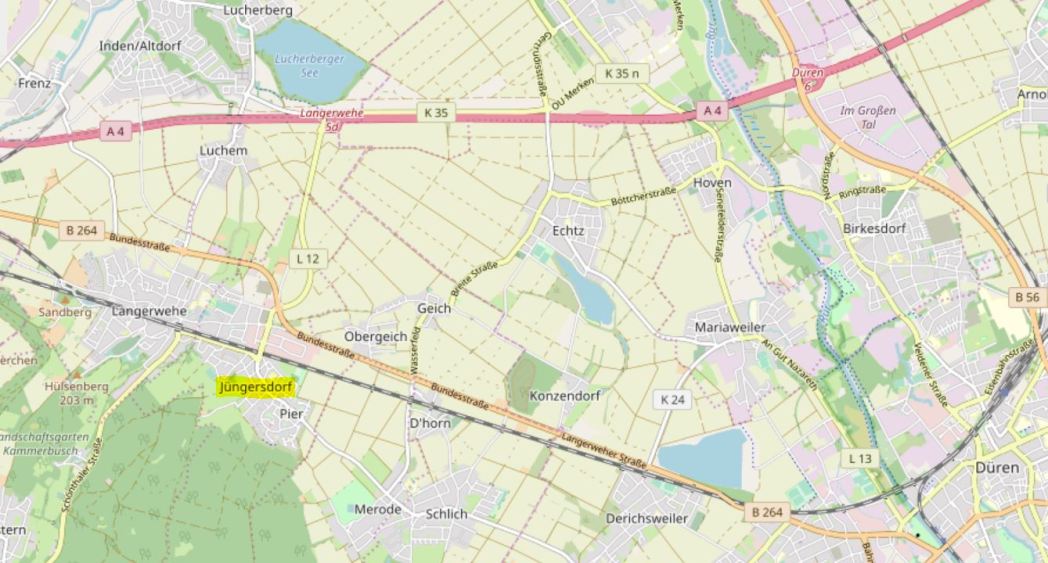
The small village of Jüngersdorf, highlighted.
The situation early December 1944.
The 39th and 60th Infantry Regiments were in V Corps reserve located at Camp Elsenborn, Belgium. They had been here since the 14th of November, when they had been relieved from the line by elements of the 99th Infantry Division. The 39th Regiment had bivouacked in the Elsenborn Forest and immediately gone into intensive training. Each battalion during this period submitted training schedules each week covering all the basic subjects. Problems on squad, platoon, and company levels were conducted, along with numerous conditioning road marches. Among other activities, were the appearance of several Red Cross Donut Dugouts, movies, ceremonies at which decorations were awarded, and by far the most enjoyable, showers and clean clothes. During these days, the returning “Purple Hearters” also arrived back to their units. The fact that these returning soldiers recovered from wounds arrived at this time helped considerably, because it gave them a chance to learn the new faces of men who had become integral parts of the units. Also it brushed them up on fighting. The training got them into the right spirit. Early December, the feeling of the 2nd Battalion, 39th Infantry Regiment men was fresh, rested, over-strength and high in morale.
Back to the front.
On the 4th of December the order came to move the 9th Infantry Division back to VII Corps where they were to go into the line and relieve the 1st Infantry Division. The 39th Infantry Regiment was designated to take over the southern sector which was held by the 26 Infantry Regiment of the 1st Division. This sector ran from the southern edge of Langerwehe south for about a mile and a half along the eastern edge of some woods. At around 0700 hours the advance party of the 39th Regiment left from Elsenborn and went to the 26th Regimental Command Post (CP) in the vicinity of Schloss Laufenburg. There the situation of the enemy and the 26th Regiment troops was outlined to the men of the 39th Regiment. It was not a very attractive one. On the way up through the woods it was decidedly evident that a terrific fight had taken place. The woods had been leveled off at about a 12 foot height by extremely heavy artillery. Also, the dead were still lay along the road, and these were not only German but also American. When American dead are still around several days after a fight, one knows that the unit there must be in a bad situation.
Upon questioning the regimental staff it was learned that the normal strength of each line company was approximately fifty men. They also heard that two companies of the 1st Infantry Division, E and F of the 26th Regiment, had been cut off and captured in the castle town of Merode. No effort had been made since the previous fighting to get out of the front edge of the woods which overlooked the open ground and the towns of Schlich, D’Horn, Merode, and Düren off on the distant skyline.
After the initial orientation the various battalion groups followed their guides to the respective units they were to relieve. The 2nd Battalion, 39th Infantry Regiment (2/39) went to the northern end of the ridge where they were met by the commanding officer of the 3rd Battalion, 26th Regiment, 1st Infantry Division. He seemed very happy that the 39th Regiment men were there and was exceptionally interested in helping them getting settled in.. The commander seemed happy with anything to hurry the relief. With a casual glance at the condition of the trees one could easily see why he was so interested. They were matchwood.
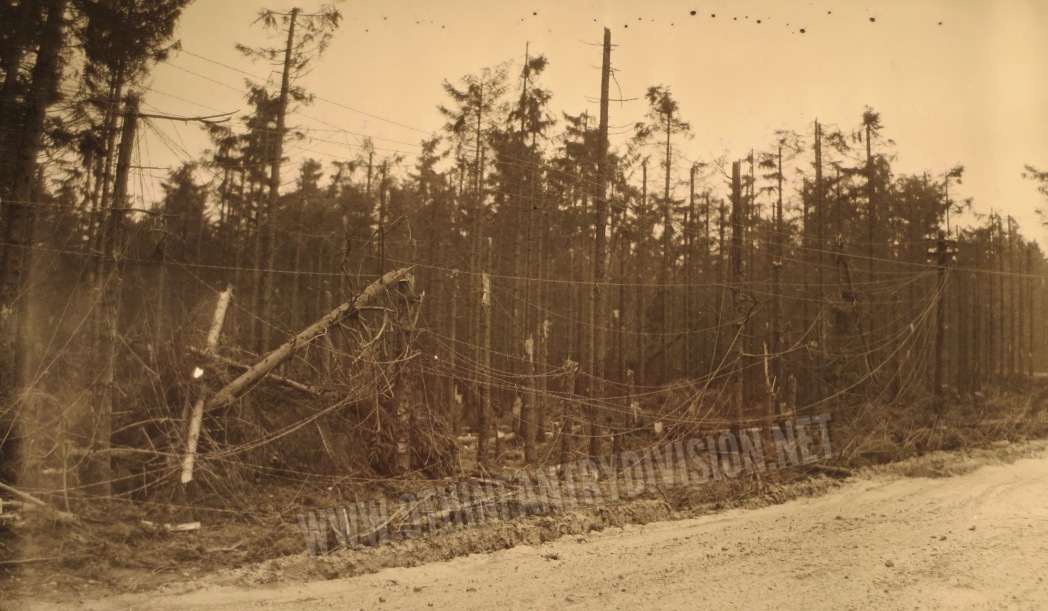
6 December 1944: Battle damaged trees in the Hurtgen Forest area.
The men now heard about preparations for an attack. This was to be the final offensive for the 9th Infantry Division and is often referred to as the “Push to the Roer”. On the 7th of December VII Corps issued the order to have the Corps attack and over-come all German resistance west of the Urft and Roer rivers. The enemy had strengthened considerably since September and the Allied troops were aware of the strong resistance in the area.
According to the issued order, the 104th Infantry Division had the objectives along the northern boundary, the 9th Infantry Division had those in the center and the 83rd Infantry Division, which had relieved the 4th Infantry Division, had the objectives along the southern sector.
The 9th Infantry Division, in conjunction with the 3rd Armored Division, was to attack east and seize and hold the towns of Geich, Obergeich, Echtz, Konzendorf, D’Horn, Schlich, Merode and Derichsweiler. The enemy defense in this area consisted of centers of resistance formed by build-up communities in the sector and dug-in positions between these communities. The enemy line was only 75 yards from the American lines at some of these points, and was held by the German 5th Parachute Regiment in the southern sector, with two battalions on the line and one in reserve. The 9th Parachute Regiment was in reserve position in the Merken – Echtz area.
A closer look at the 9th Infantry Division’s objectives:
Southeast of the town of Lucherberg, just north of Luchem, is a lake which, when viewed from the air, resembles the outline of a man’s head. The northeast bank of this lake is almost straight and parallels a farmer’s roadway which leads into the town itself. The first mission of the attack was to capture and hold the south easternmost tip of this lake and extend to include the territory to the Autobahn (German highway) towards Echtz later. The mission had the effect of protecting the Division’s left flank and was assigned to the 1st Battalion, 47th Infantry Regiment.
The second phase began with an afternoon attack of the 60th Infantry Regiment under command of Colonel Van Houten to the east in coordination with Combat Command R (CCR) of the 3rd Armored Division to seize the towns of Obergeich, Geich and Rothaus. This would outflank the German strong point of Schlich and Merode which up to this time had kept the Americans pinned to the edge of the woods at the base of the hill due east of Merode. They were also to hold the town of Konzendorf. Following the seizure of Echtz by CCR, the 60th was to relieve the Armored Division and prepare to meet enemy counterattacks from any direction.
While Colonel Van Houten moved his 60th Infantry Regiment north of the blacktop Aachen – Duren highway, Colonel Bond’s 39th Infantry Regiment was to wait along the sloping extremities of the woods to the south of the road. The 39th was to attack east from the vicinity of Jüngersdorf along the railroad which parallels the blacktop highway and seize the town of D’Horn. When both Geich and Obergeich had been captured, a signal was to be given and the regiment would attack and seize the towns of Schlich and Merode.
In order to get to D’Horn, the 39th Infantry Regiment had to go through the town of Jüngersdorf. This town was taken earlier on the 27th of November 1944 by men of the 26th Infantry Regiment of the 1st Infantry Division. During the night of the 27-28 November, the German 5th Parachute Regiment attempted a counter-attack to regain the village of Jüngersdorf. However, this attack was stopped, and the German attackers pulled back to a location behind the railroad tracks just north of the town.
The 39th Regimental attack would not start before 1200 hours because the 60th Regiment did not start their attack on the Geiches until 1200 hours. That meant that the 2nd Battalion would attack in broad daylight. This produced another problem. The terrain over which the attack was to take place was, from the front edge of Jüngersdorf to the near side of D’Horn, about 1700 yards of nothing but slightly sloping grass land, flat, and not one single bush anywhere to be found. From the German viewpoint, it was merely a matter of shooting at sitting ducks from their positions. To make matters even worse, the ground was extremely soggy. Midway between the two towns was a small ditch system which was a drain and looked extremely soft, which later turned out to be the matter. This “panoramic” view as seen by the men of E and Go Companies during the five days prior to the attack did not bolster their morale.
Field Artillery Support.
With this situation and the order to attack, Lt. Col. Frank L. Gunn, 2nd Battalion, 39th Regiment Commander, went to work studying the terrain and figuring out a way of how he could use it to his advantage, if possible. The first worry was that of getting across the open area without any casualties. Gunn collected all ideas offered by various members of the battalion staff such as suggestions of smoke, covering fire from small arms or make use of support by artillery. After several hours a few decisions were made. The first was to start immediately.
One 155mm Artillery Battalion was to fire with delay fuzes into the area between the two towns. The thought behind this was to dig holes and thus provide the infantry a possible means of cover if the Germans halted them out in the open ground. Everyone knew that previously artillery was being rationed when it came to ammunition so with that and the fact that you had to have nothing less than a target consisting of a battalion strength of enemy before they would shoot, it was figured best to get hot on the plan. Captain Bryant, Battalion Artillery Liaison Officer, did lots of talking and finally got certain Corps Artillery Battalions to shoot several concentrations at D’Horn and then had them moved back into the open area and fire a concentration or two.
With the first part out of the way and in operation, Lt Col Gunn drew up the rest of the plan. The battalion would move out with E Company leading and going directly to their objective, D’Horn. At four to five hundred yards G Company would follow. As the latter got about five hundred yards from D’Horn it would move to the left and cross over the railroad fill, then move on into that part of D’Horn to the left of the tracks. F Company, now located in the town of Langerwehe, would move to Jüngerdorf the night before the attack and remain there as battalion reserve. H Company was split up as a section of heavy machine guns would be attached with each attacking company, while the remaining platoon of machine guns would be set up in Jüngersdorf and give overhead fire during the attack.
The platoon of tanks from A Company 746th Tank Battalion, which was attached to the 2nd Battalion of the 39th Regiment, was assigned the mission of moving out with the leading E company. Not behind, but right up with the front platoons. A platoon of Tank Destroyers which were also attached to the 2nd Battalion, was assigned the mission of picking covered positions in Jüngersdorf to which they would move when the attack started and fire on pre-observed targets, plus any of opportunity. Oddly enough, they were very pleased with this plan and thought it excellent. Finally came the use of the supporting artillery, the Regimental Cannon Company, and the battalion’s own 81mm mortars.
On the left flank a railroad track ran along the top of a 12 to 20 foot hill which started about 400 yards east of Jüngersdorf. This furnished excellent protection against both fire and observation from the left flank. However, the objective to the front was wide open and the right flank was not only open but covered by two towns; Schlich and Merode, both strongly held by the Germans. It wasn’t very hard to determine from this, as to what would be primary targets to shoot at, but what kind of fire should be put and where had to be figured out. After much discussion with Capt Bryant, and with the 26th Field Artillery Battalion, a plan was made that went as follows:
The towns of D’Horn, Schlich and Merode would receive time fire from the 26th Field Artillery Battalion initially at H minus 10 hours, then at H hour smoke would be placed to the north of Schlich and Merode concealing any observation from those towns. The time fire on D’Horn was to continue till lifted by the leading attacking company. Then move to a greater range and fire on Derichsweiller.
The 26th Field Artillery actions for 10 – 12 December 1944:
The 34th Field Artillery Battalion (155mm) and the Regimental Cannon Company were to fire on Derischweiller where it was believed that the Germans had mortar positions. H Company’s 81mm mortars were to initially supplement the artillery fires on Schlich and Merode after which they had to be prepared to give support to either attacking company as they got into D’Horn.
The 34th Field Artillery Battalion actions for 10 – 12 December 1944:
These parts of the plan were immediately sent out to the people concerned, with the idea that knowing in advance what was expected they could commence stockpiling a little extra ammunition and register. From here on minor plans and administrative procedures were ironed out. Feeding, issuing extra ammunition and obtaining special grenades, in fact everything was set. Except for H hour, a time which would be governed by the attack of the 60th Regiment and elements of the 3rd Armored Division, both on the 2nd Battalion’s left flank. They were to jump-off at 1200 hours and take the towns of Geich and Obergeich before the 2nd Battalion moved out.
TIME PRIOR TO THE ATTACK
Everyone in the battalion settled down to wait. Plans had been made and all were thoroughly oriented. Nothing was left out. It just could not miss this time. All was fine, the weather cleared and on the 9th of December, spirits in the battalion headquarters were high. On this day, the 9th Infantry Division prepared itself for the VII Corps offensive starting the next day, and probed forward with reconnaissance units.
At about noon a little incident occurred that was like a spark to tinder. From then on it was one trouble after another. The only road from Langerwehe to Jüngersdorf that could be used ran right through a German farm. A big building built around a courtyard, then over the hill and into Jüngersdorf. This last part was exposed to the enemy and movement over it had been restricted to the time of darkness. The Battalion Commanding Officer had personally found this out on the 5th of December when he had been sniped at with a rather large gun while trying to make a run for it in his jeep. This one road was the supply route and was to be used to take the tanks and battalion anti-tank guns over that night. It had to be kept open. A 4.2 inch mortar platoon moved in and set up in the farm yard. They dug in fast and got set to register. Upon questioning it was found that they were to support the 60th Regiment on the 39th’s left and thought that they had a perfect position.
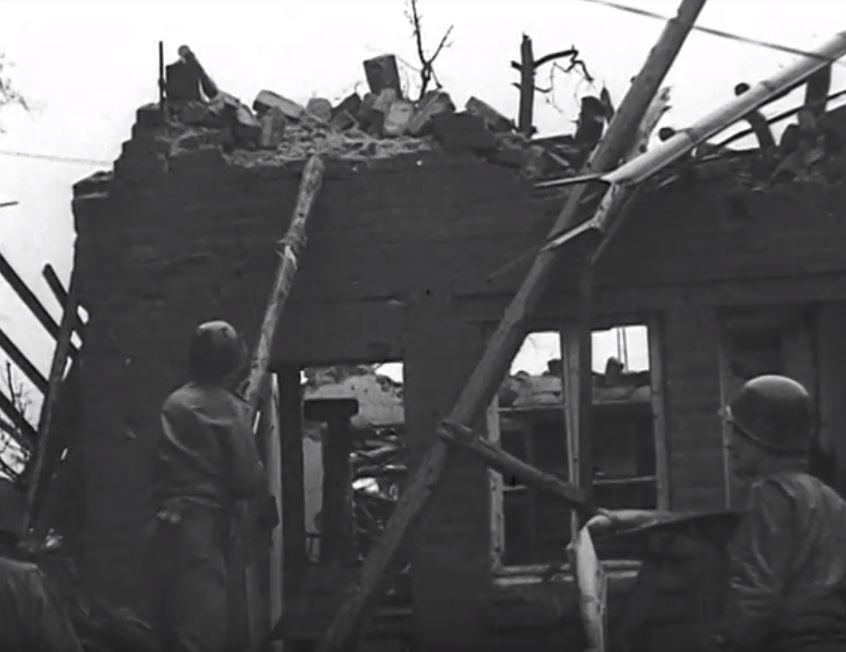
4.2 inch Mortar Crew Preparing positions.
After a short orientation and lesson on the reasons for the boundaries the chemical mortars moved out. Just at the moment the battalion staff settled down and drew a sigh of relief, a linesman came in and said a half-track was stuck and wanted some help. One of the battalion officers went out to see what could be done. Lo and behold, here was one of the 4.2 inch mortar platoons ammunition carriers, a half-track loaded with ammunition half off the road and in mud two feet deep. This blocked the road again because it was only a one way road and the opposite edge was also too muddy for vehicles to operate over. A little deliberation and discussion was followed by getting a tank up and hauling the half-track out. Engineer tape was then put out to help guide the vehicles that night.
Jüngersdorf.
Initially the 2nd Battalion of the 39th Regiment was to occupy positions in the town of Jüngersdorf and along the front of the wooded area to the south. But that changed and the whole battalion was to go into Jüngersdorf. This was decided at about 1130 hours and so the battalion was intercepted back on the route of march, halted, and moved off the road awaiting night-fall.
The town of Jüngersdorf was on the forward slope of an open hill and could not be entered during daylight. Several of the advance party had tried it but were sniped down by a large caliber gun. Thus the idea of trying to personally contact the units in town was temporarily dropped.
All was quiet till dark except for German artillery, that had kept up continuously for the whole time. Most was destined for friendly artillery one terrain feature back, but there were a surprising number of shorts. At dark troubles started again. Around 1930 hours, a combat command of the 3rd Armored Division parked on the main road right outside the battalion Command Post. A mere 80 vehicles but all seemed to be huddled between where the platoon of tanks was and the entrance to the supply road. This group was to stay there till the adjacent attack jumped off the next day.
Moving tanks at night under such conditions was not easy but with the combined efforts of all the battalion staff and F Company Officers, it was finally accomplished and all the battalion vehicles and attached tanks got through and into Jüngersdorf. The battalion’s Command Post moved into Jüngersdorf along with F Company and prepared for the next day’s operation. When darkness fell E and G Companies also moved forward into Jüngersdorf, relieving the units of the 26th Regiment of the 1st Division At 2100 hours all was settled and the 26th Regiment had moved completely, including their outposts.
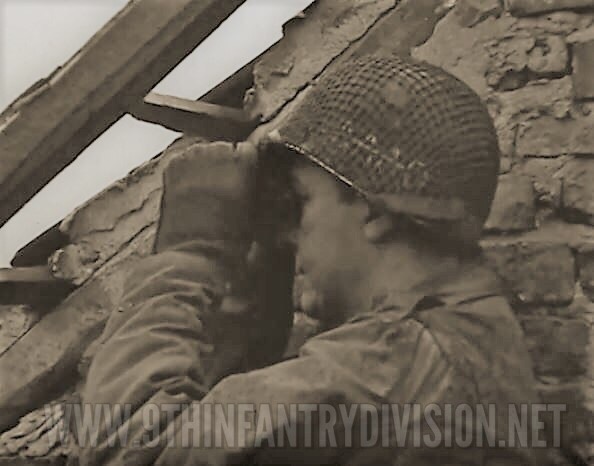
39th Infantry Regiment soldier observing enemy movements and targets.
THE ATTACK
For the past several days there had been no activity. Rest and hot meals had been great. Then came the 10th of December, another clear sunny day. Time passed quickly with every one busy, tinkering around with little odds and ends but still busy, trying to keep their mind off of that open area. At 1200, the 60th Infantry Regiment, with elements of the 3rd Armored Division, jumped off toward the towns of, Geich and Obergeich. It was quite a show from 2nd Battalion’s Observation Post. The adjacent area to the north could be seen for 2 miles and the whole attack could be observed. A special Sherman mine-exploder company led the unit of the 60th Regiment nearest to the 2nd Battalion’s boundary. It was odd looking at tanks with tremendous metal disks being pushed in front. Then, about halfway to the town of Geich, an anti-tank gun got a direct hit on the leading mine-exploder tank. From then on the attack slowed and almost halted. Time passed quickly. First it was 1300, then soon it was 1400 and everyone started to get a little concerned because the 2nd Battalion was to move out after the 60th Regiment got Geich and Obergeich. It looked from the OP it would be quite some time before word would come saying they had taken the two objectives. Some time between 1430 and 1450 hours, General Collins, the VII Corps Commander, stopped by the 39th Regimental CP and inquired as to the progress of the attack. When told that the 2nd Battalion was still waiting word from the 60th Regiment, he immediately stated that the battalion should move out now and not wait.
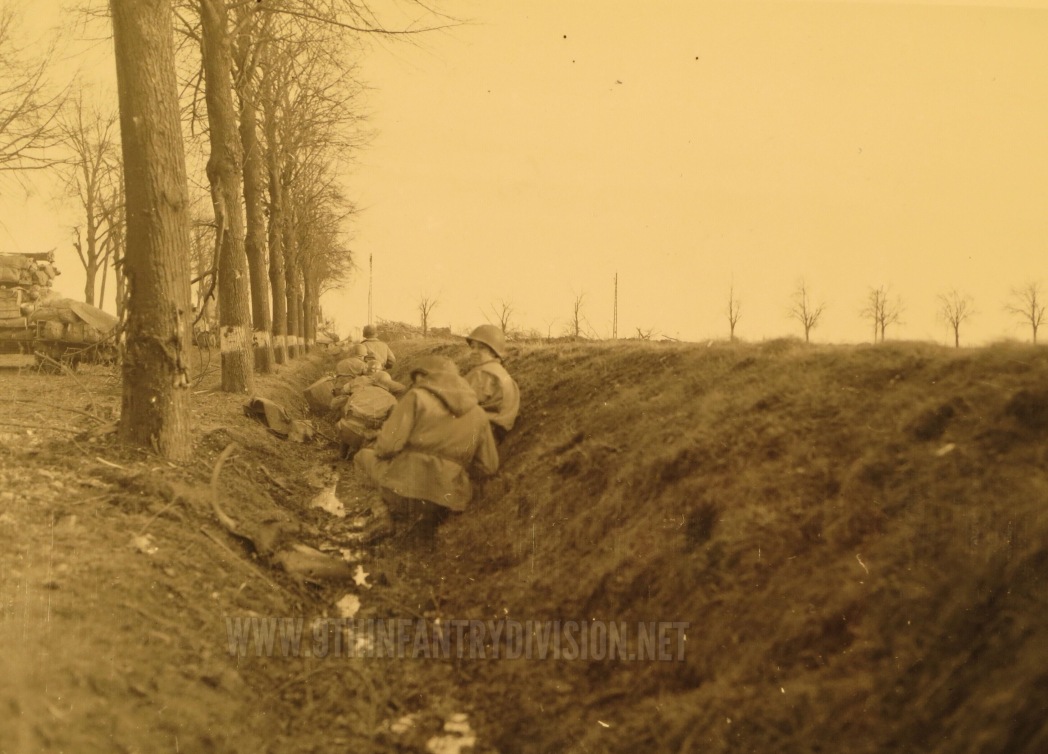
60th Infantry Regiment men take cover in a ditch near Obergeich.
After a telephone conversation between the Battalion and Regiment, time was set for the jump off at 1515 hours. Word went to E and G Companies, tanks, tank destroyers, mortars, and artillery battalions. At 1505 hours, the artillery started as planned. D’Horn, Schlich and Merode were well covered. Next, the smoke started to spread and covered these last two villages. There were minor adjustments of the supporting fires, but on the whole all went perfectly and according to plan. At 1515, E Company moved out of Jüngersdorf as ordered and into the open.
Supporting Easy Company were the tanks, but only two instead of the four in the platoon. The fifth, a tank dozer, was left in Langerwehe to go via the highway after the objective was taken. The ground had been too soft and two tanks had gotten mired in the first 50 yards in an orchard. When the leading company was out in the open, all supporting weapons were too. Tank Destroyers had opened up on the targets designated to them, heavy machine guns of H Company cut loose with overhead fire and mortars were being pushed to their maximum. Although not mentioned before, .50 caliber machine guns available in the battalion at the time were also firing. It was learned too that supporting fires were coming from the other two battalions in the regiment and their targets were Merode and Schlich.
E Company had cleared Jüngersdorf by now and was about half way across the field when a call came over the radio from the artillery “Smoke is running out; will have to stop shortly”. Immediately the Liaison Officer and the Battalion Commander went to work calling everyone they knew trying to get more smoke. No matter where they turned they got the same answer, “Sorry, can’t do!”. So the artillery had to cut the density. Luckily the wind was perfect and the smoke drifted the right way, north-west. The Battalion 81mm’s then proved themselves by taking up where the artillery left off. They had gotten all the smoke possible and were able to perform a perfect job. Added to this a platoon of 4.2 inch chemical mortars which were just put in support of this attack helped out.
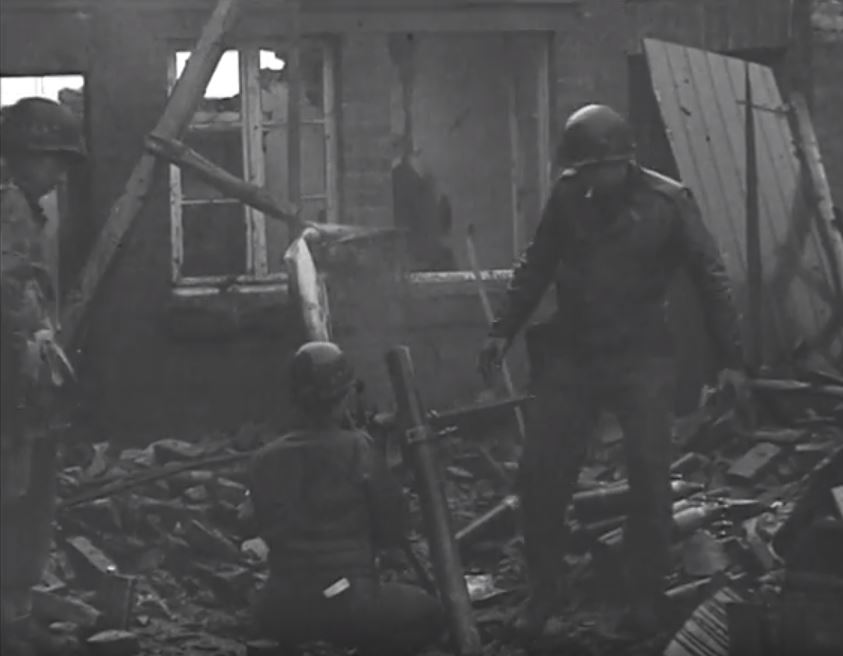
81mm Mortar Crew in action at Jungersdorf. Note the AAA-O on the helmets.
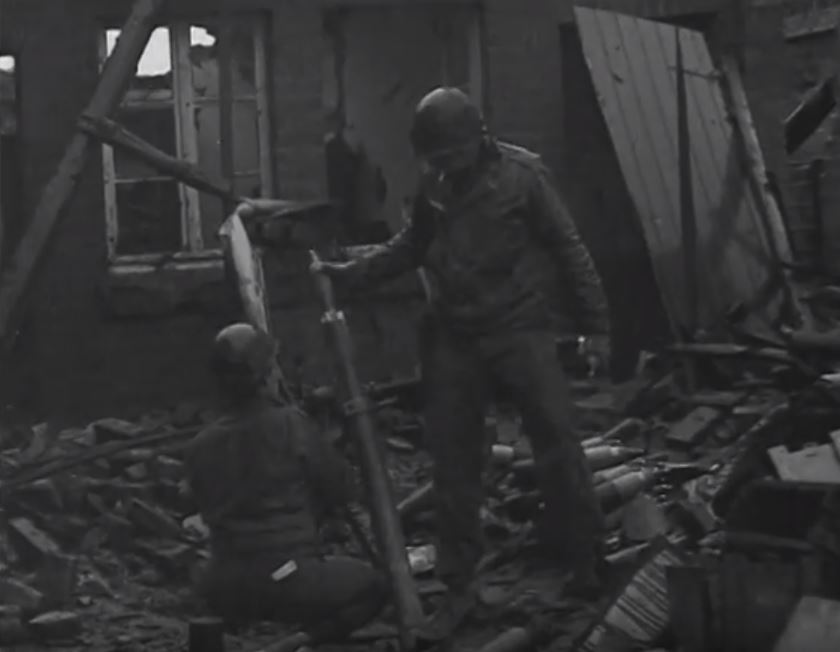
81mm Mortar Crew in action at Jungersdorf.
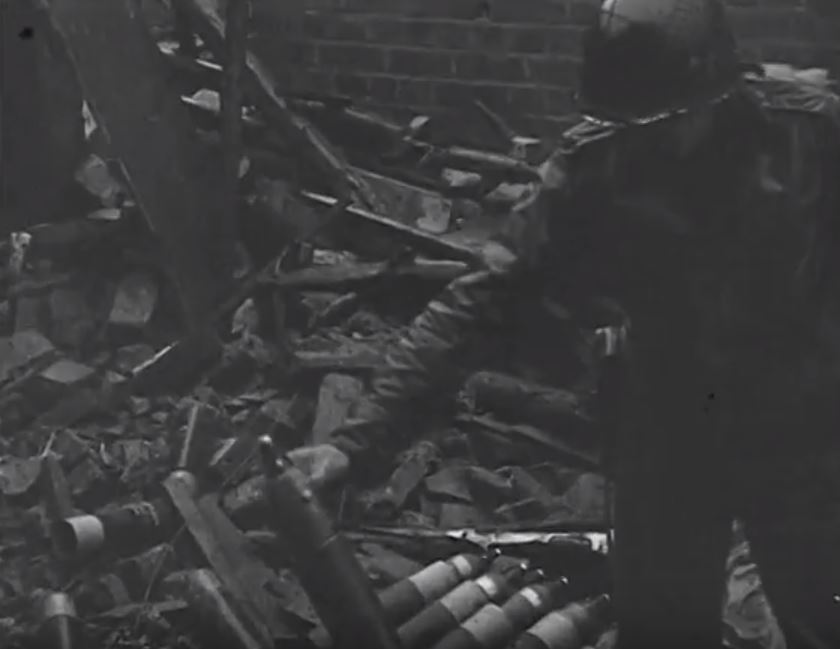
4.2 inch Mortar Crew firing a round from the Farmhouse courtyard.
Then E Company started to receive enemy mortar fire. It seemed to land right in the middle of the company formation. Nothing could be done at the time so the company kept on moving. By now they had crossed the greater part of the open ground. Behind them and in the field were a number of odds and ends and a minefield of box mines. Due to the extreme dampness of the ground these mines did not go off when run over by the remaining tanks. Another tank got stuck in the mud. A number of casualties were waiting for litter-bearer men, and a group of German prisoners was being herded back. This latter group was evidently an outpost group picked up in their holes.
Taking of D’Horn and more German prisoners.
By now, E Company was nearing the town of D’Horn. From the OP they could see the last tank bog down and stop 400 yards short of the town. Shortly afterwards a call came over the SCR-300 from E Company saying: “Lift the artillery we are moving in”. Within a matter of seconds the calls were put in and the air suddenly cleared over the town. The artillery had lifted. Colonel Gunn was able to advance his battalion abreast of the 60th Regiment as far as D’Horn. With his left now covered by the 60th he turned at right angles, attacking toward the village. The company quickened their pace and moved in on the double. Small arms fire could be heard. The reports that came back were all favorable and within half an hour E Company had cleared the town of D’Horn, taking a sizable number of prisoners and organizing to meet any possible counterattack.
G Company moved out and followed the same path as E Company for about 1200 yards and then crossed over the tracks to the left without any incident other than rounding up a number of prisoners and receiving sporadic small arms fire. G Company captured their section of the objective with very little resistance. Before the artillery fire lifted, the H Company machine guns which had initially given the overhead fire support had gone out of action and moved out to join both companies on the objective.
The German prisoners.
Once the town of Jüngersdorf was secured from all opposition, German prisoners came from various places in and around the town, but the men pictured in the well known photographs were most likely to come from the town of D’Horn. These were loaded onto an American truck and dropped off at the Kapellenstrasse in Jüngersdorf. From here they walked to the farm called “Jüngersdorfer Hoff”, located at the same street. Below are some still from archival footage shot on December 12th, 1944.
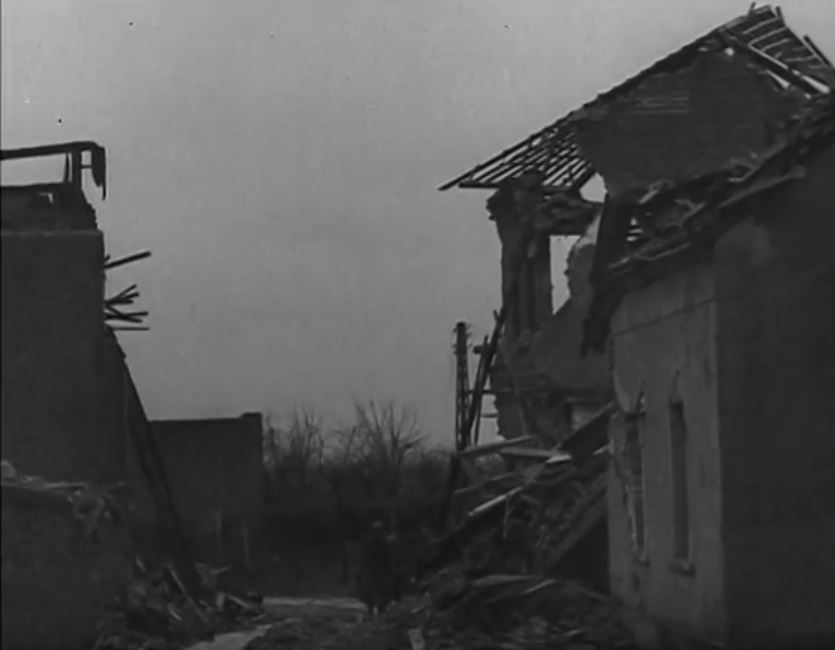
The first prisoners arrive by truck – parked just behind the corner on the right.
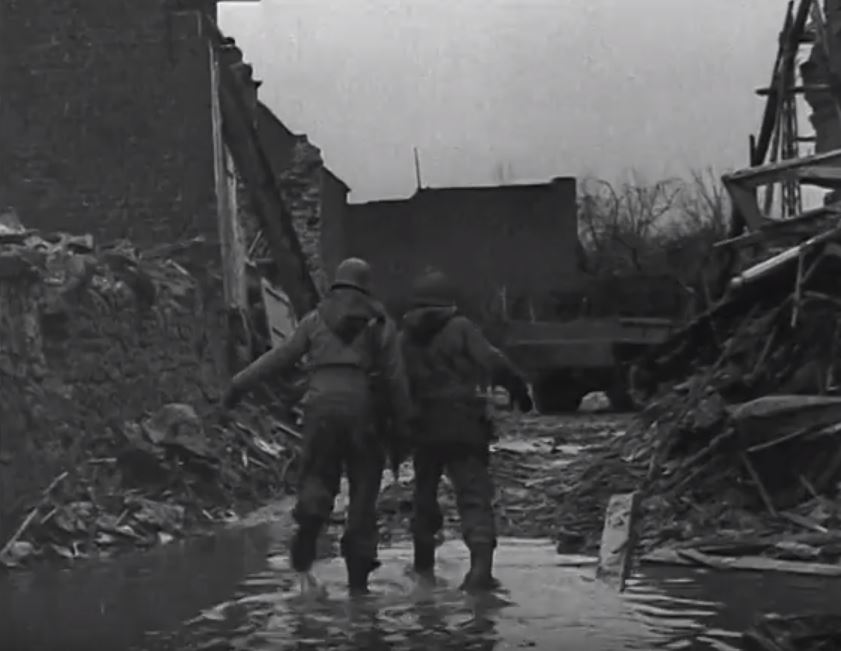
2 American GIs walk towards the truck to pick up the prisoners.
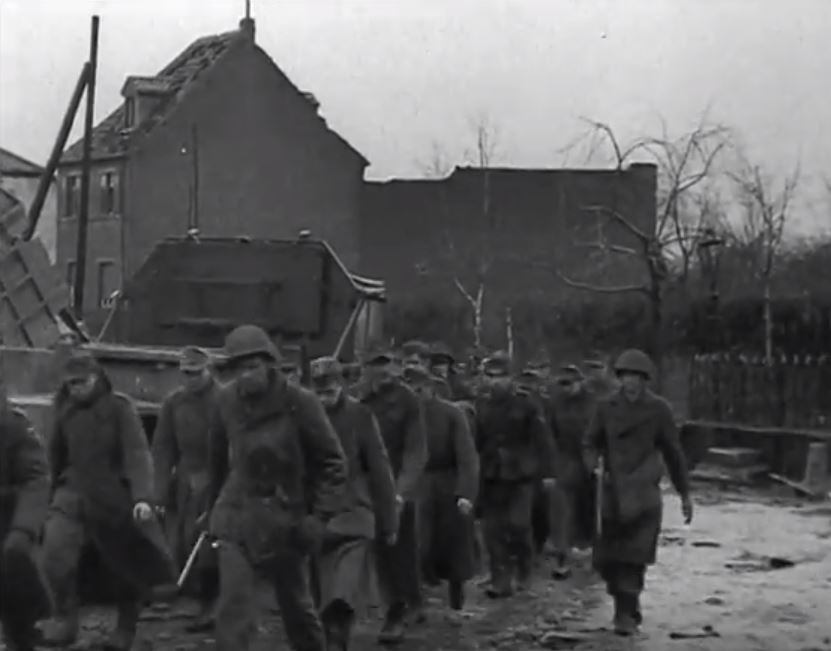
The first German prisoners arrived.
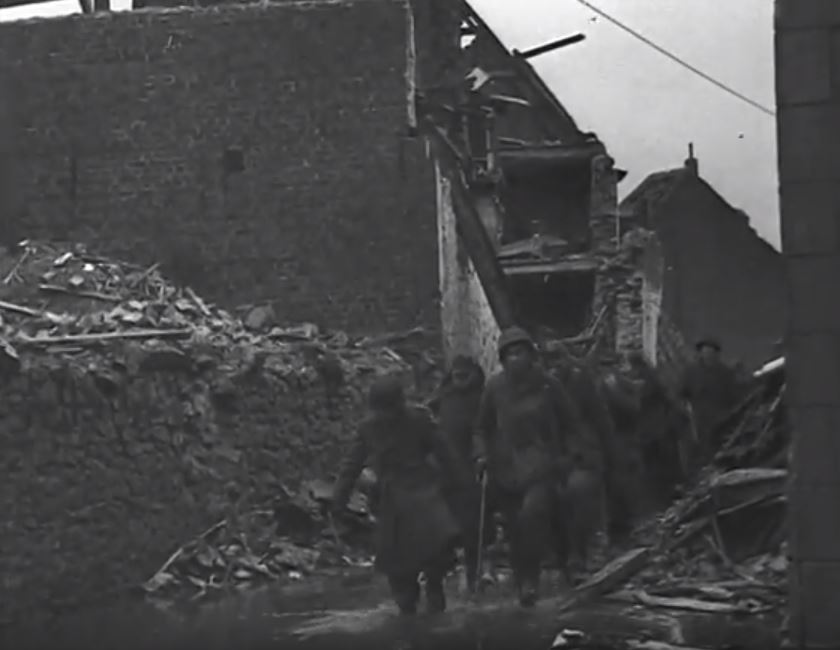
German prisoners walk on the Kapellenstrasse.
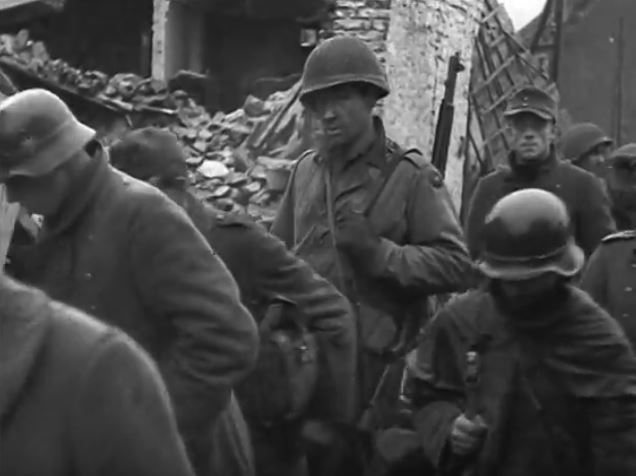
Soon after, more German prisoners arrived, and walked to the Jungersdorfer Hof.
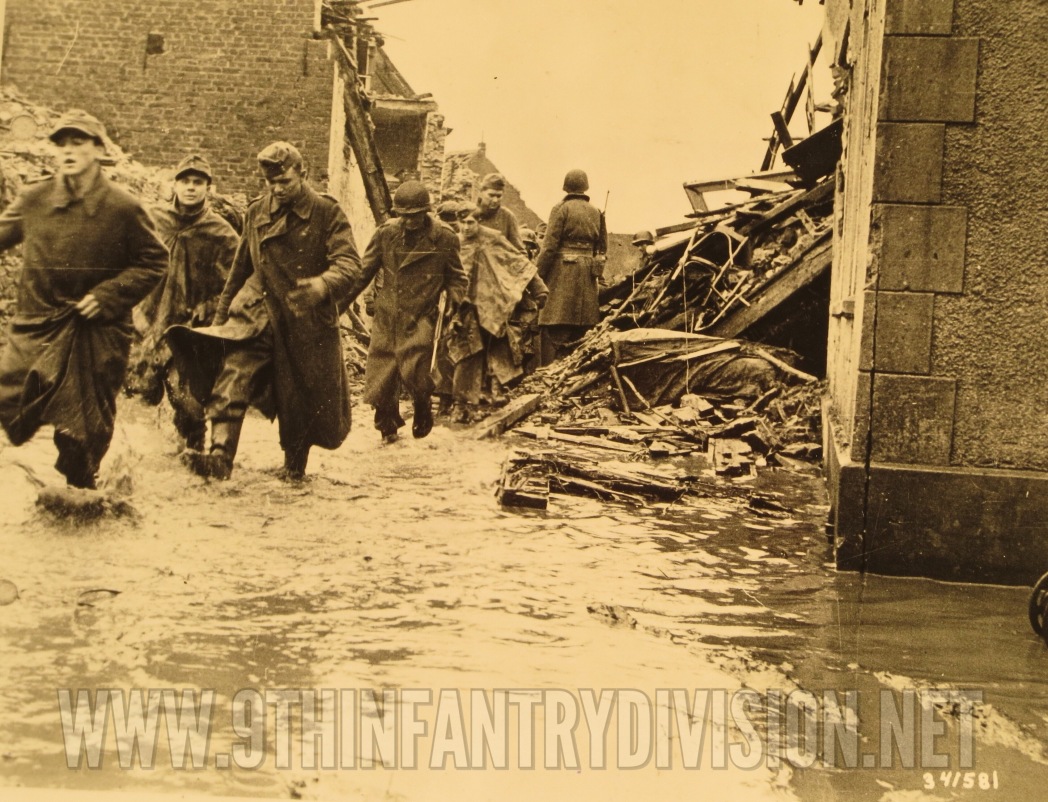
German prisoners walking on Kapellenstrasse, Jungersdorf.
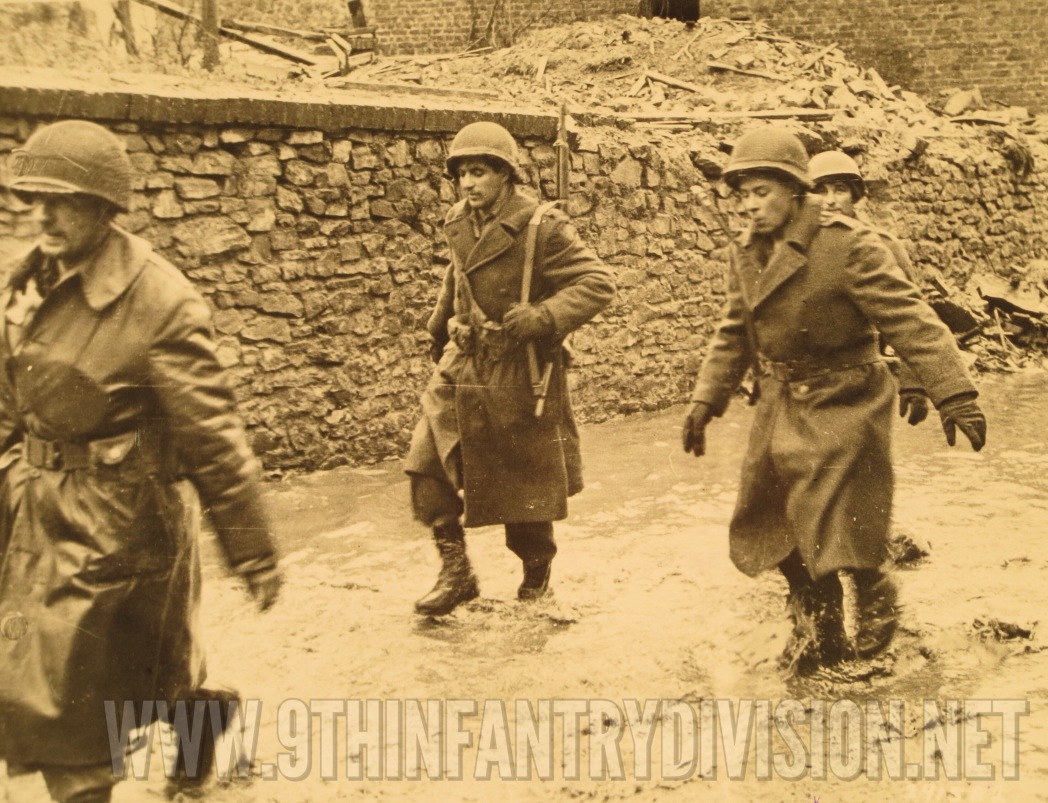
The US soldiers of 2nd Battalion, 39th Infantry Regiment guarding the German prisoners.
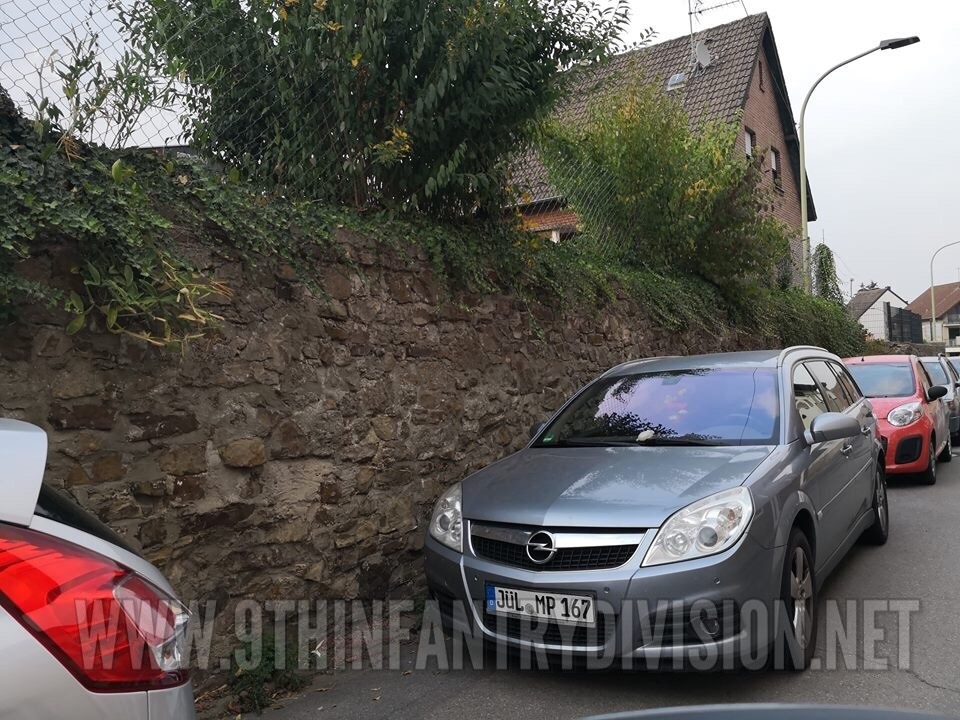
The same spot today – Kapellenstrasse in Jungersdorf.
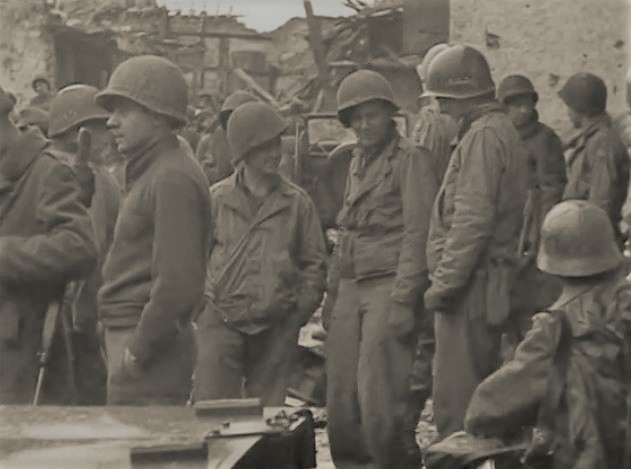
US GIs of 2nd Bn, 39th Infantry Regiment at the Jungersdorfer Hof.

The German prisoners rounded up at the Jungersdorfer Hof.

The Jungersdorfer Hof today. Same spot.
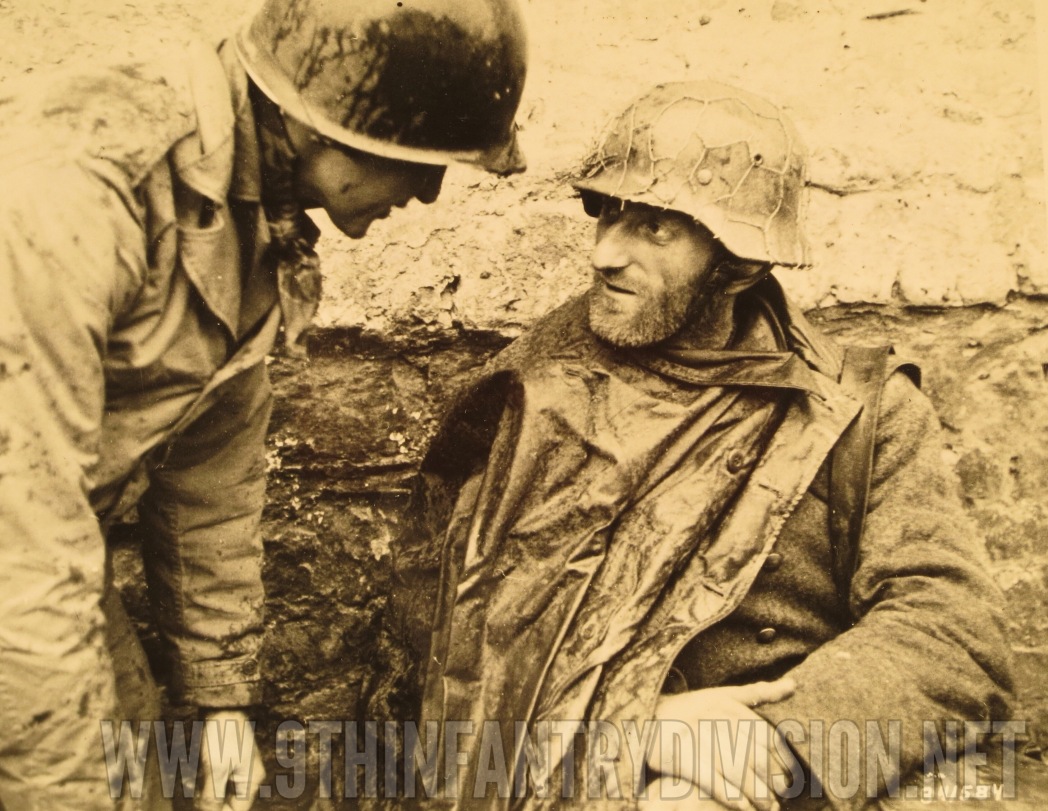
An American soldier talks to one of the German prisoners.
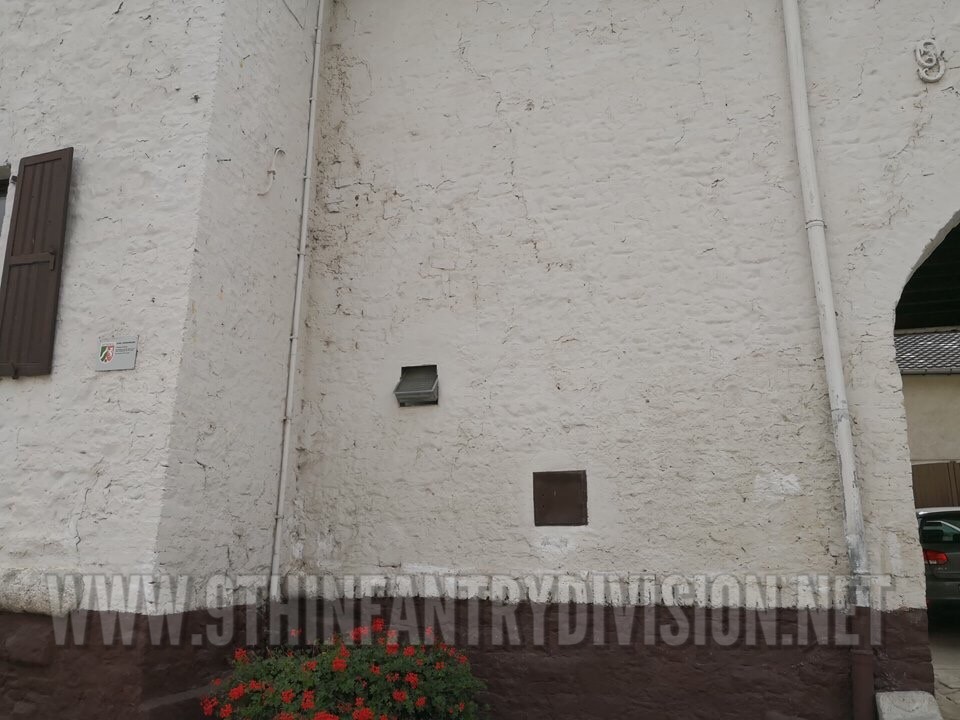
The same spot today.
The entire action to completely secure Jüngersdorf and take D’Horn had taken about one to one-half hours and was completed before darkness.
In Jüngersdorf several men of the 39th Infantry Regiment found one of the German guns used to fire at them.
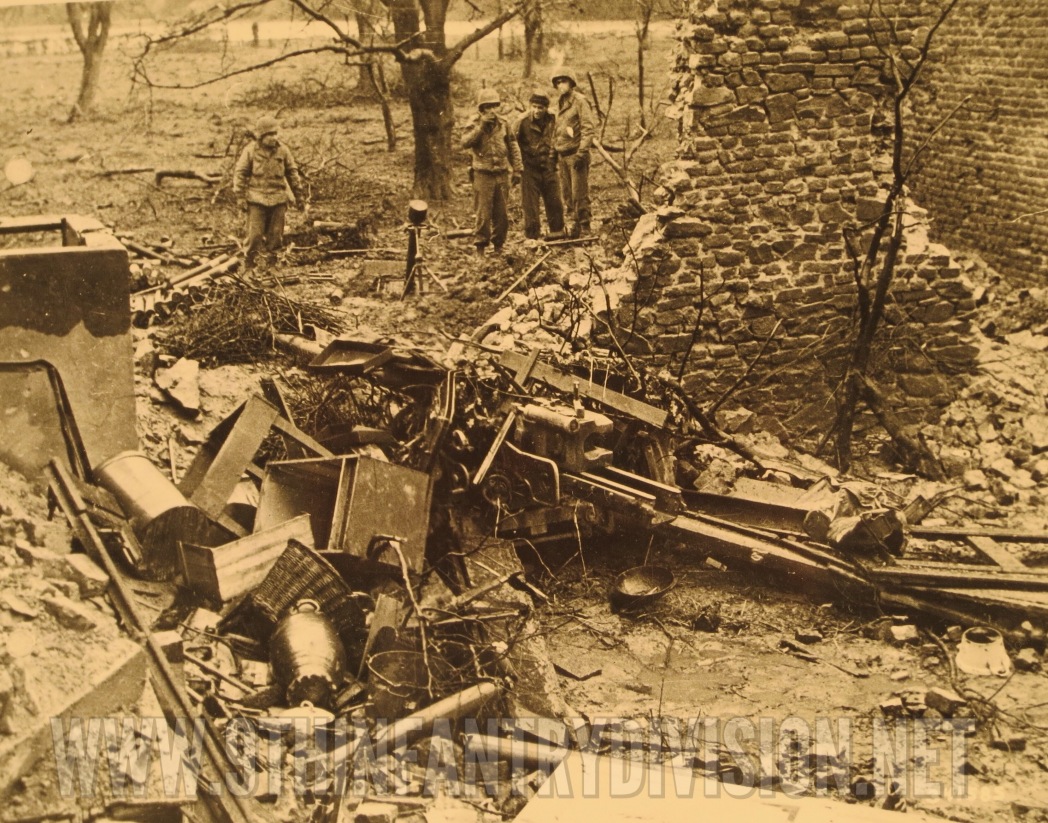
German Gun and mortar at the edge of the village.
Now as it grew dark the reorganizing got under way for the attack the next day on Schlich as the other two battalions of the regiment moved out against Merode. The highway in the 60th Regiment’s zone was supposedly opened and permission to use it was granted to the 39th Regiment’s 2nd battalion for the use of supplying the companies. Wire was laid along the railroad track and all were tied in for the night. Till the next morning all was quiet in the 2nd Battalion sector except for occasional enemy artillery fire. It had been a long day for the 9th Infantry Division.
Company I, 39th Infantry Regiment in Jüngersdorf?
While researching the actions for these days, I noticed something odd. The text that comes with the original archival pictures of the German prisoners mentions that the American soldiers pictures were part of Company I, 2nd Battalion, 39th Infantry Regiment. Now, I find this information confusing.
Clearly, Company I would be part of 3rd Battalion, not 2nd Battalion. Then I checked all the After Action Reports and documents on 3rd Battalion for the days of 10 – 12 December 1944. I Company was heavily engaged in fighting at Derichsweiler and Schlich on December 12th, 1944. They were not part of taking Jüngersdorf at all. 2nd Battalion men, mainly E and G Companies fought in and around Jüngersdorf on their way to their main objective, D’Horn. We can safely say that the men pictured are men of 2nd Battalion, and most probably of E or G Company, 39th Infantry Regiment.

Wrong information? Company I / 3rd Battalion?
A special thank you to Maren Esser for providing the “now” pictures of Jüngersdorf.
Another thank you to Albert Trostorf for providing the following After Action Report: “Operations of the 2nd Battalion, 39th Infantry Regiment, 9th Infantry Division, in the Attack on D’Horn, Germany, December 4 – 10 1944, Rhineland Campaign“. Personal Experience of an assistant member on the Battalion Staff, Captain Arvid P. Croonquist Jr.
For the text in this article I relied heavily on this report, as well as the 9th Infantry Divisional unit book “Eight stars to victory”. I also used Albert Trostorf’s book “Gegen das Vergessen 2” to verify the dates that Jüngersdorf was taken by the 1st Infantry Division.
I also made some stills of the following video footage shot by Sgt. Newman and Laurence on 12 December 1944. It is amazing that a lot of scenes described in the After Action Reports were filmed and can be seen in this archival footage.







